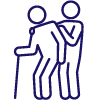Here's the text.
About home evacuation
Last Updated April 9, 2024
What is Home Evacuation?
Evacuation at home is a method of living in a familiar home instead of evacuating to evacuation shelter if there is no danger of collapse or burning at home when a major earthquake occurs.
As many evacuees gather in evacuation shelter, the space available to each individual is very small, making it difficult to ensure privacy. Even those who are evacuating from home can register as evacuees by filling out and submitting an "evacuee card" at evacuation shelter and receive supplies at evacuation shelter at a later date. You can live a stress-free evacuation life by receiving supplies in evacuation shelter as needed while living in a familiar home. In preparation for evacuation at home, store food and toilet packs, etc., and prevent furniture from falling over.
Stockpiling
Image of Rolling Stock
It is important to stock up on food and daily necessities necessary for living at home on a daily basis. Stock up on what you need for at least three days (preferably one week) according to the environment and family structure of each household.
Necessary items for evacuation life, such as food and daily necessities, are stockpiled a little more on a daily basis, consumed in everyday life, and purchased more as much as used. You can always store a certain amount of stock. Let's advance stockpiling while checking the expiration date and expiration date regularly.
About toilet measures in the event of a disaster
Home toilets may not be usable due to water outages due to disasters or damage to drain pipes. Furthermore, in apartment, if water is drained without checking whether drain pipes can be used, sewage on the upper floor may overflow from toilets on the lower floor. In addition to toilet packs and simple toilets, it is also possible to make emergency toilets using garbage bags and newspapers in case of emergency. Assuming that you cannot use your home toilet, stock up on toilet packs for at least 3 days (preferably 1 week).
※The average number of excretions per day is said to be 5 times. Estimated is 5 times a day per person x at least 3 days (15 times).
About safety measures in the house
In order to evacuate home, it is important that your home be able to live. Let's try to create a safe environment by making the building earthquake-resistant and preventing furniture from falling.
[Business Guide]
・Furniture Fall Prevention Measures Subsidy Project (City of Yokohama, General Affairs Bureau Regional Disaster Prevention Division)
・Seismic breakers Installation Promotion Project (City of Yokohama, General Affairs Bureau Regional Disaster Prevention Section)
・I want to make the house earthquake-resistant, but what should I start? For those who think that (City of Yokohama, Housing and Architecture Bureau Building and Disaster Prevention Section)
About precautions when evacuating at home
[Water drainage during large-scale earthquakes]
In the event of a major earthquake, sewer pipes in invisible places may be damaged. Do not flush bathtubs and toilet water until the safety of the drainage system is confirmed. In the case of apartment, it may cause water leakage to the lower floor or overflow of sewage, so do not drain it until the management company inspects it.
[Confirmation of water stations in the event of a disaster]
In the event of a large-scale earthquake, the water may be cut off. The place where anyone can get drinking water when the water is cut off due to a disaster is the "disaster water station".
In Water Works Bureau, reservoirs, underground water tanks for disasters, emergency hydrants and earthquake-resistant hydrants are installed as water stations in the event of a disaster. In case of emergency, let's check the water station near you with evacuation shelter.
[Receiving daily necessities]
Even when you evacuate from home, you can receive daily necessities, but in that case you need to go to evacuation shelter to get them. Even in evacuation shelter, it is important to store food and daily necessities on a regular basis, as it is not always possible to obtain the necessary supplies immediately.
[Acquisition of Disaster Information]
In the event of a major earthquake, it is important to know local disaster information. Information on the damage situation, evacuation shelter, city and ward will also be gathered in evacuation shelter, so you need to go to evacuation shelter to check if necessary. In addition, let's acquire information positively by utilizing TV and radio, homepage of city.
Inquiries to this page
Kanagawa Ward General Affairs Department General Affairs Division
Telephone: 045-411-7004
Telephone: 045-411-7004
Fax: 045-324-5904
Email address: kg-somu@city.yokohama.lg.jp
Page ID: 422-471-994












